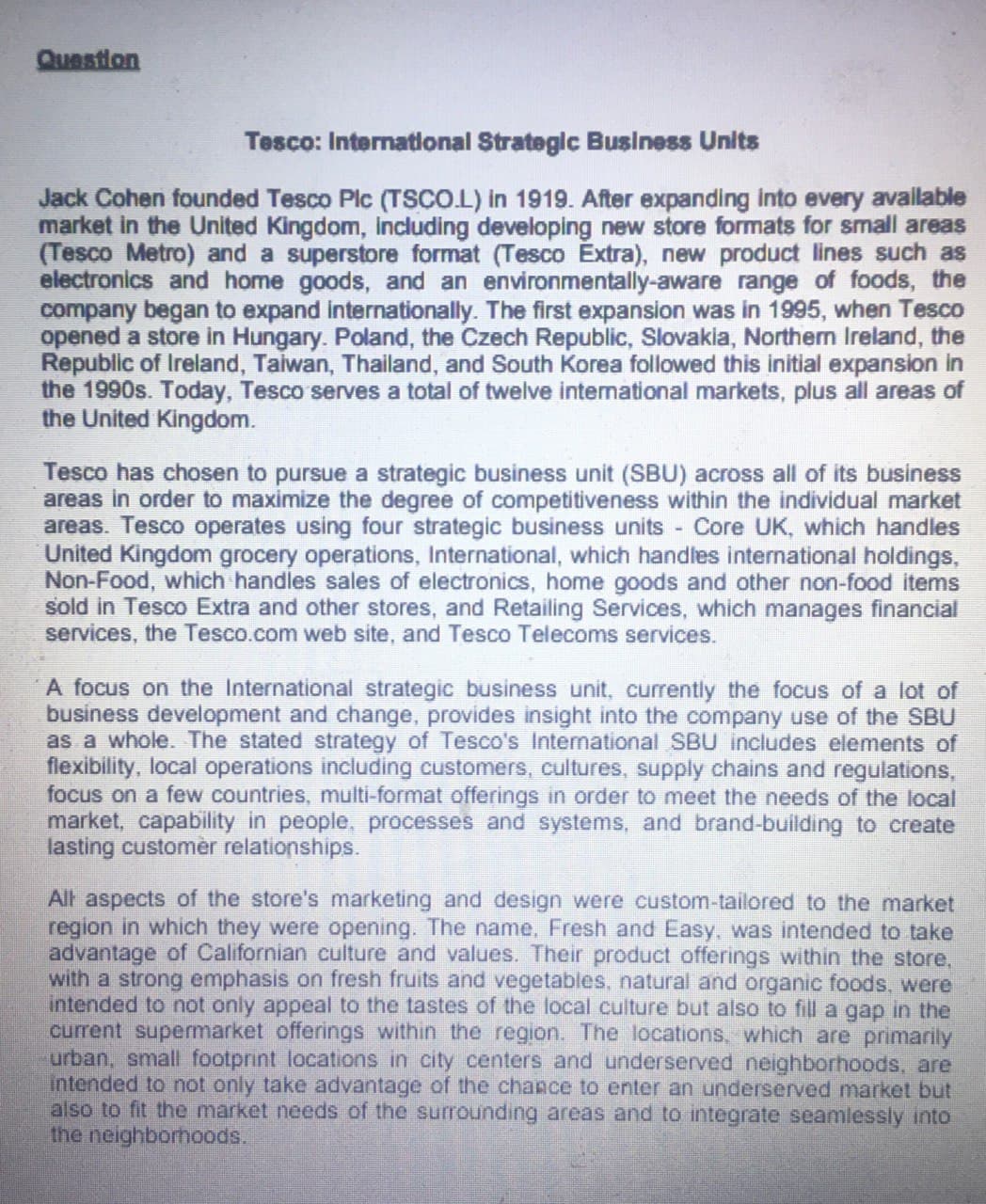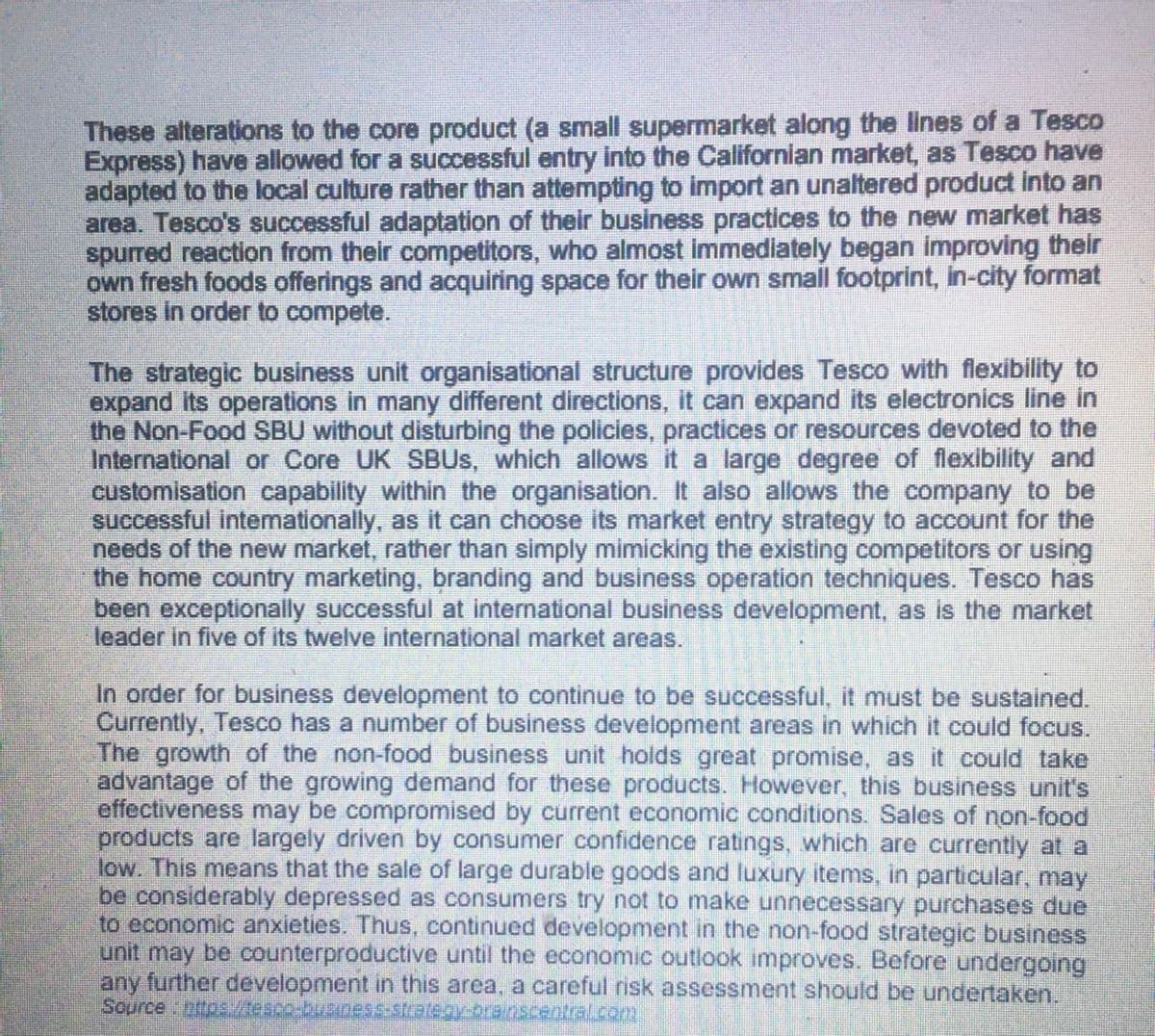Based on the article above, Tesco choose to pursue SBU structure across all its business areas for maximising the degree of competitiveness. Advise Tesco based on your opinion on the success of TESCO upon pursuing the selected sturucture as the main tool to overcome competitors. Answer should be with relevent examples. Thank you in advanced
Based on the article above, Tesco choose to pursue SBU structure across all its business areas for maximising the degree of competitiveness. Advise Tesco based on your opinion on the success of TESCO upon pursuing the selected sturucture as the main tool to overcome competitors. Answer should be with relevent examples. Thank you in advanced
Practical Management Science
6th Edition
ISBN:9781337406659
Author:WINSTON, Wayne L.
Publisher:WINSTON, Wayne L.
Chapter2: Introduction To Spreadsheet Modeling
Section: Chapter Questions
Problem 20P: Julie James is opening a lemonade stand. She believes the fixed cost per week of running the stand...
Related questions
Question
Question 1
Based on the article above, Tesco choose to pursue SBU structure across all its
business areas for maximising the degree of competitiveness. Advise Tesco based on
your opinion on the success of TESCO upon pursuing the selected sturucture as the
main tool to overcome competitors.
Answer should be with relevent examples. Thank you in advanced

Transcribed Image Text:Question
Tesco: International Strategic Business Units
Jack Cohen founded Tesco Plc (TSCO.L) in 1919. After expanding into every avallable
market in the United Kingdom, Including developing new store formats for small areas
(Tesco Metro) and a superstore format (Tesco Extra), new product lines such as
electronics and home goods, and an environmentally-aware range of foods, the
company began to expand internationally. The first expansion was in 1995, when Tesco
opened a store in Hungary. Poland, the Czech Republic, Slovakia, Northem Ireland, the
Republic of Ireland, Taiwan, Thailand, and South Korea followed this initial expansion in
the 1990s. Today, Tesco serves a total of twelve intenational markets, plus all areas of
the United Kingdom.
Tesco has chosen to pursue a strategic business unit (SBU) across all of its business
areas in order to maximize the degree of competitiveness within the individual market
areas. Tesco operates using four strategic business units Core UK, which handles
United Kingdom grocery operations, International, which handles international holdings,
Non-Food, which handles sales of electronics, home goods and other non-food items
sold in Tesco Extra and other stores, and Retailing Services, which manages financial
services, the Tesco.com web site, and Tesco Telecoms services.
A focus on the International strategic business unit, currently the focus of a lot of
business development and change, provides insight into the company use of the SBU
as a whole. The stated strategy of Tesco's International SBU includes elements of
flexibility, local operations including customers, cultures, supply chains and regulations,
focus on a few countries, multi-format offerings in order to meet the needs of the local
market, capability in people, processes and systems, and brand-building to create
lasting customèr relationships.
All aspects of the store's marketing and design were custom-tailored to the market
region in which they were opening. The name, Fresh and Easy, was intended to take
advantage of Californian culture and values. Their product offerings within the store,
with a strong emphasis on fresh fruits and vegetables, natural and organic foods, were
intended to not only appeal to the tastes of the local culture but also to fill a gap in the
current supermarket offerings within the region. The locations, which are primarily
urban, small footprint locations in city centers and underserved neighborhoods, are
Intended to not only take advantage of the chance to enter an underserved market but
also to fit the market needs of the surrounding areas and to integrate seamlessly into
the neighborhoods.

Transcribed Image Text:These alterations to the core product (a small supermarket along the lines of a Tesco
Express) have allowed for a successful entry into the Californian market, as Tesco have
adapted to the local culture rather than attempting to import an unaltered product into an
area. Tesco's successful adaptation of their business practices to the new market has
spurred reaction from their competitors, who almost immediately began improving their
own fresh foods offerings and acquiring space for their own small footprint, in-city format
stores in order to compete.
The strategic business unit organisational structure provides Tesco with flexibility to
expand its operations in many different directions, it can expand its electronics line in
the Non-Food SBU without disturbing the policies, practices or resources devoted to the
International or Core UK SBUS, which allows it a large degree of flexibility and
customisation capability within the organisation. It also allows the company to be
successful intemationally, as it can choose its market entry strategy to account for the
needs of the new market, rather than simply mimicking the existing competitors or using
the home country marketing, branding and business operation techniques. Tesco has
been exceptionally successful at international business development, as is the market
leader in five of its twelve international market areas.
In order for business development to continue to be successful, it must be sustained.
Currently, Tesco has a number of business development areas in which it could focus.
The growth of the non-food business unit holds great promise, as it could take
advantage of the growing demand for these products. However, this business unit's
effectiveness may be compromised by current economic conditions. Sales of non-food
products are largely driven by consumer confidence ratings, which are currently at a
low. This means that the sale of large durable goods and luxury items, in particular, may
be considerably depressed as consumers try not to make unnecessary purchases due
to economic anxieties. Thus, continued development in the non-food strategic business
unit may be counterproductive until the economic outlook improves. Before undergoing
any further development in this area, a careful risk assessment should be undertaken.
Expert Solution
This question has been solved!
Explore an expertly crafted, step-by-step solution for a thorough understanding of key concepts.
Step by step
Solved in 2 steps

Recommended textbooks for you

Practical Management Science
Operations Management
ISBN:
9781337406659
Author:
WINSTON, Wayne L.
Publisher:
Cengage,

Operations Management
Operations Management
ISBN:
9781259667473
Author:
William J Stevenson
Publisher:
McGraw-Hill Education

Operations and Supply Chain Management (Mcgraw-hi…
Operations Management
ISBN:
9781259666100
Author:
F. Robert Jacobs, Richard B Chase
Publisher:
McGraw-Hill Education

Practical Management Science
Operations Management
ISBN:
9781337406659
Author:
WINSTON, Wayne L.
Publisher:
Cengage,

Operations Management
Operations Management
ISBN:
9781259667473
Author:
William J Stevenson
Publisher:
McGraw-Hill Education

Operations and Supply Chain Management (Mcgraw-hi…
Operations Management
ISBN:
9781259666100
Author:
F. Robert Jacobs, Richard B Chase
Publisher:
McGraw-Hill Education


Purchasing and Supply Chain Management
Operations Management
ISBN:
9781285869681
Author:
Robert M. Monczka, Robert B. Handfield, Larry C. Giunipero, James L. Patterson
Publisher:
Cengage Learning

Production and Operations Analysis, Seventh Editi…
Operations Management
ISBN:
9781478623069
Author:
Steven Nahmias, Tava Lennon Olsen
Publisher:
Waveland Press, Inc.